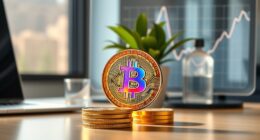The BEP-95 burn mechanism on BNB Chain automatically integrates token burning into every transaction fee you pay in BNB. When you make a transaction, a portion of the fee is burned, permanently removing tokens from circulation, which can increase scarcity and potentially raise the token’s value. This process happens seamlessly without extra steps, fostering a deflationary environment that benefits long-term ecosystem health. Keep exploring to understand how this mechanism shapes BNB’s future.
Key Takeaways
- BEP‑95 links token burning directly to transaction fees on BNB Chain, reducing supply with each transaction.
- A portion of transaction fees is burned, permanently removing BNB tokens from circulation to create scarcity.
- Burning increases token scarcity, potentially boosting BNB’s value over time through deflationary pressure.
- The mechanism is automatic and transparent, requiring no extra steps from users during transactions.
- It incentivizes network activity and long-term ecosystem growth by integrating token burning into regular usage.

To grasp how BNB Chain’s BEP‑95 burn mechanism works, it’s important to understand its purpose: reducing token supply to increase scarcity and potentially boost value. This process relies on a method called token burning, which involves permanently removing a portion of tokens from circulation. In the context of BEP‑95, token burning is directly linked to transaction fees. Every time you make a transaction on the BNB Chain, a small fee is paid in BNB tokens. Instead of these fees going to miners or validators, a portion is burned—permanently destroyed. This setup creates a built-in mechanism to decrease the total supply of BNB over time.
When you initiate a transaction, the fee you pay is automatically split into two parts: one part goes to the network operators (like validators), and the other part is burned. The burning process reduces the overall circulating supply of BNB, which can lead to increased scarcity. As supply diminishes, the value of remaining tokens might rise, especially if demand stays steady or increases. This dynamic encourages token holders and traders to consider the long-term effects of token burning, knowing that each transaction can contribute to a more limited supply.
The transaction fee in the BEP‑95 system acts as a catalyst for token burning. Instead of paying a fee solely for transaction processing, you’re participating in a deflationary mechanism that benefits the ecosystem. The fee structure is transparent and automatic; you don’t need to take extra steps for tokens to be burned. Every transaction you complete contributes to this process, which over time can significantly influence the overall tokenomics of BNB. The more active the network, the more tokens are burned, potentially leading to a reduction in circulating supply and, in theory, an increase in token value.
Understanding this process helps you see how BEP‑95 aligns incentives among users, developers, and investors. It creates a deflationary pressure that can enhance the token’s scarcity and desirability. As a participant, you’re not just paying a fee—you’re actively helping to shape the token’s economics. This mechanism also encourages network activity, as users recognize that their transactions play a role in the token’s long-term health and value. By designing a system where transaction fees lead to token burning, BNB Chain fosters a sustainable model that could benefit all stakeholders through increased token scarcity and potential value appreciation. Additionally, the incorporation of high refresh rates and other technological features can further improve the performance and appeal of the network.
Frequently Asked Questions
How Does BEP-95 Compare to Other Token Burn Mechanisms?
BEP-95 stands out among token burn strategies by automating burning through a burn bucket linked to transaction fees, promoting blockchain deflation. Unlike traditional methods that rely on manual burns, BEP-95‘s real-time approach guarantees continuous supply reduction, potentially increasing token value. This mechanism offers a more efficient, transparent way to control inflation and align incentives, making it a unique and innovative solution compared to other token burn mechanisms.
What Impacts Does the Burn Mechanism Have on Bnb’s Price Stability?
You’ll find that the BEP-95 burn mechanism reduces BNB’s supply by consistently removing tokens, creating token scarcity that can boost market confidence. This scarcity helps stabilize BNB’s price by preventing inflation and encouraging demand. Since the burn is automatic and transparent, investors trust that supply decreases will support long-term stability, making BNB more attractive. This process ultimately fosters a healthier, more resilient market for BNB holders.
Are There Any Risks Associated With the BEP-95 Burn Process?
Yes, there are risks with the BEP-95 burn process. You should be aware of security concerns, as vulnerabilities in the smart contract could lead to unintended burns or theft. Additionally, regulatory challenges may arise, especially if authorities view the burn mechanism as altering token supply in ways that impact market stability or consumer protection. Staying vigilant and ensuring robust security measures can help mitigate these risks.
How Often Are BNB Tokens Burned Under BEP-95?
Under BNB-95, tokens are burned regularly, roughly every quarter, creating token scarcity that can influence the market impact. This scheduled burning reduces the total supply, potentially increasing the value of remaining tokens. You should keep an eye on the burn schedule, as consistent reductions can impact token availability and market dynamics over time, ultimately affecting your holdings and the overall ecosystem’s health.
Can Users Influence or Participate in the Burn Process?
Yes, you can influence and participate in the burn process through community participation and user influence. By engaging in governance proposals or supporting initiatives that promote token burns, you help shape the network’s future. Your active involvement, such as voting or spreading awareness, contributes to the burn mechanism’s effectiveness. Ultimately, your participation empowers the community and aligns token burns with collective goals, making the process more transparent and democratic.
Conclusion
Now that you understand BNB Chain’s BEP-95 burn mechanism, you can see how it’s transforming the way tokens are managed and destroyed. This innovative process isn’t just a small tweak; it’s a game-changer that’s reshaping the entire crypto landscape. By actively participating or simply observing, you’re witnessing an evolution so powerful, it’s like fireworks lighting up the sky—bright, bold, and impossible to ignore. Get ready, because the future of crypto burns just got a whole lot brighter!









